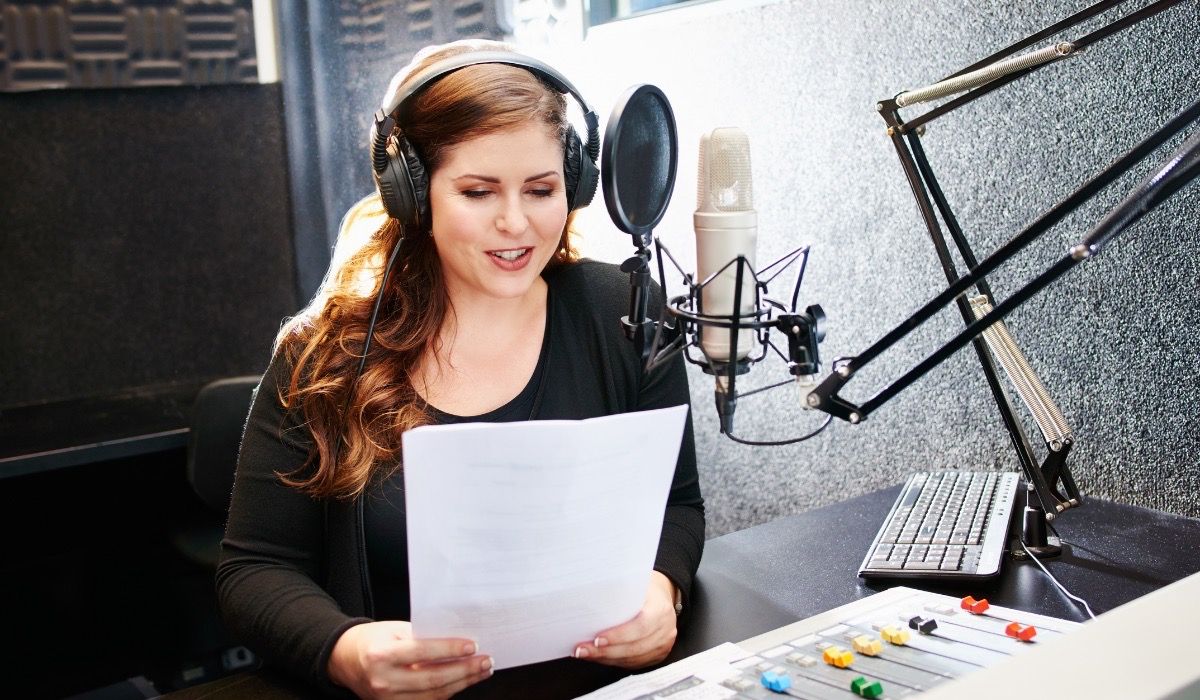Home>Devices & Equipment>Radio>How To Write A Radio Script


Radio
How To Write A Radio Script
Modified: March 7, 2024
Learn the best techniques and tips to write a captivating radio script, covering all aspects of radio production. Enhance your storytelling skills for effective radio broadcasting.
(Many of the links in this article redirect to a specific reviewed product. Your purchase of these products through affiliate links helps to generate commission for AudioLover.com, at no extra cost. Learn more)
Table of Contents
- Introduction
- Understanding the Basics of Radio Scripts
- Choosing a Format for Your Radio Script
- Developing a Compelling Concept
- Creating Engaging Characters
- Crafting Captivating Dialogue
- Planning the Structure of Your Radio Script
- Writing an Attention-Grabbing Opening
- Building Tension and Conflict
- Incorporating Sound and Music
- Writing Effective Scene Transitions
- Adding Sound Effects
- Incorporating Advertising and Sponsorship Messages
- Formatting Your Radio Script
- Editing and Revising Your Radio Script
- Final Thoughts and Additional Tips
Introduction
Welcome to the exciting world of radio scripting! Writing a radio script is a unique and thrilling endeavor that allows you to captivate listeners through the power of sound and dialogue. Whether you’re creating a thrilling radio drama, a catchy commercial, or an engaging talk show, understanding the art of radio scriptwriting is crucial to delivering a compelling and memorable broadcast.
In this guide, we will explore the fundamental elements of writing a radio script, from choosing the right format to crafting captivating characters and dialogue. Whether you’re a seasoned radio professional or a newcomer to the medium, this article will equip you with the essential tools and techniques to create a script that resonates with your audience.
Writing a radio script differs from other forms of writing, such as film or television scripts, because the audio element is the primary means of storytelling. Without visuals to rely on, you must rely solely on the power of words, sound effects, and music to create immersive and engaging experiences for your listeners.
Throughout this guide, we will delve into the key aspects of radio scriptwriting, including the importance of a strong concept, the art of crafting compelling characters and dialogue, and the technicalities of incorporating sound effects and music. We will also discuss how to weave advertising and sponsorship messages seamlessly into your script, preserving the integrity of your content without sacrificing the needs of your sponsors.
So let’s dive in and unlock the secrets of writing an exceptional radio script that will captivate, entertain, and leave a lasting impression on your audience.
Understanding the Basics of Radio Scripts
Before diving into the world of radio scriptwriting, it’s important to grasp the fundamental components that make up a radio script. Unlike other forms of writing, radio scripts are driven by the power of sound and rely on dialogue to convey the story or message efficiently.
One key aspect to understand is the concept of “theater of the mind.” Rather than relying on visuals, radio scripts encourage listeners to use their imagination to create vivid mental images. This means that descriptive language and sound effects are vital in painting a picture and engaging the audience’s senses.
Another essential element of radio scripts is pacing. Unlike visual mediums, where the viewers can take in the information at their own pace, radio scripts need to keep the audience engaged and interested. This requires concise and impactful dialogue, capturing attention from the very first line and maintaining momentum throughout.
Additionally, it’s important to consider the target audience when crafting a radio script. Are you targeting a specific demographic? Are they well-versed in the topic or do you need to provide more explanation? Understanding your audience will help shape the tone, style, and content of your script.
Furthermore, radio scripts often incorporate sound effects and music to enhance the storytelling. These audio elements can be used to create atmosphere, set the mood, or add emphasis to key moments in the script. It’s essential to think about the desired impact of these elements and how they can enhance the overall listening experience.
Lastly, when writing a radio script, it’s crucial to keep in mind the constraints of the medium. Unlike visual content, which allows for flexibility in showcasing settings and actions, radio scripts are limited to what can be conveyed through sound and dialogue alone. Therefore, it’s important to be creative and find innovative ways to express emotions, convey information, and engage the listeners without the aid of visuals.
Understanding these basics of radio scriptwriting will serve as a solid foundation as we delve further into the different aspects of creating a successful radio script. From developing a concept to planning the structure and incorporating sound effects, each element is crucial in delivering an engaging and captivating radio broadcast.
Choosing a Format for Your Radio Script
When it comes to writing a radio script, choosing the right format is essential to effectively convey your message or tell your story. The format you choose will depend on the type of content you want to create and the objectives you aim to achieve. Let’s explore some common formats for radio scripts:
- Drama: The drama format is perfect for creating fictional stories, mysteries, or even adaptations of famous novels. Drama scripts often include dialogue, narration, sound effects, and music to bring the story to life. This format allows for character development, plot progression, and creating a captivating narrative.
- Comedy: If your goal is to entertain and make your audience laugh, the comedy format is the way to go. Comedy scripts rely on witty dialogue, comedic timing, and humorous situations to engage listeners. Whether it’s a sitcom-style script or a sketch comedy, this format offers ample opportunities for creativity and wordplay.
- Talk Show: Talk show scripts are ideal for hosting discussions, interviews, or educational programs. This format requires engaging and informative dialogue between the host and guests, as well as well-researched content. Talk show scripts often involve planned questions, talking points, and natural conversation flow.
- Documentary: If you’re aiming to provide factual information, raise awareness, or tell a real-life story, the documentary format is a great choice. These scripts typically combine narration, interviews, and sound effects to deliver a compelling and informative listening experience. It’s important to conduct thorough research to ensure accuracy and credibility.
- Commercial: When it comes to promoting a product, service, or event, commercial scripts are essential. These scripts require concise and persuasive language to grab the listener’s attention and convey the benefits of the offering. Commercial scripts often incorporate sound effects, catchy jingles, and a clear call to action.
It’s important to choose a format that aligns with your goals, target audience, and the resources available to you. Consider factors such as the length of the script, the desired tone and style, and the impact you want to make. Remember to tailor your script to suit the unique characteristics of radio broadcasting and make the most of the audio medium.
By selecting the right format for your radio script, you’ll set the stage for delivering a compelling and engaging broadcast that resonates with your audience.
Developing a Compelling Concept
A well-developed concept serves as the foundation for any successful radio script. It sets the tone, establishes the themes, and provides a roadmap for the entire scriptwriting process. Here are some key steps to follow when developing a compelling concept for your radio script:
- Identify your objective: Determine the main purpose of your radio script. Are you aiming to entertain, educate, inspire, or inform the audience? Clarifying your objective will help guide your concept and shape the content of your script.
- Research and brainstorm: Dive into research to gather ideas, inspiration, and relevant information for your concept. Explore various sources, such as books, articles, interviews, or personal experiences. Brainstorming sessions with a team or by yourself can generate fresh and innovative ideas.
- Focus on uniqueness: Strive for a concept that stands out from the crowd. Consider what makes your idea different, interesting, or relevant to the target audience. Finding an angle or perspective that hasn’t been explored extensively can help capture listeners’ attention.
- Define the theme: Determine the key theme or message you want to convey through your script. It could be love, friendship, overcoming challenges, social issues, or any other theme that resonates with your intended audience. The theme adds depth and coherence to your script.
- Create a memorable hook: Craft a compelling hook that grabs the listeners’ attention from the start. It could be a thought-provoking question, a captivating scenario, or a compelling statement. The hook should immediately engage the audience and make them curious to hear more.
- Consider the target audience: Keep your target audience in mind throughout the concept development process. Understand their interests, preferences, and demographics to tailor your concept to their needs. This will help you create content that resonates and connects with them on a deeper level.
- Structure and plot: Outline the structure and plot of your script. Determine the major plot points, key scenes, and character arcs. Create a logical progression that keeps the audience engaged and builds tension and anticipation.
- Embrace creativity: Don’t be afraid to think outside the box and experiment with unconventional ideas. Incorporate unexpected twists, unique characters, or innovative narrative techniques to make your concept memorable and captivating.
Remember that a compelling concept is the backbone of a successful radio script. Take the time to refine your ideas, seek feedback from others, and ensure that your concept resonates with your intended audience. With a strong concept in place, you’ll have a solid foundation for creating a compelling and engaging radio script that will captivate listeners.
Creating Engaging Characters
One of the key elements of a successful radio script is the creation of engaging and memorable characters. These characters bring your script to life and connect with your audience on an emotional level. Here are some tips to help you create compelling characters for your radio script:
- Develop unique traits: Give each character distinct personality traits, quirks, and motivations. This will make them relatable and interesting to the listeners. Consider their background, beliefs, and desires to create well-rounded and three-dimensional characters.
- Create relatable conflicts: Conflict is vital in driving the story forward and keeping the audience engaged. Introduce conflicts that the characters must overcome, whether they are internal struggles or external obstacles. This adds depth to your characters and provides opportunities for growth and development.
- Use dialogue to reveal character: Dialogue is a powerful tool for revealing a character’s personality, thoughts, and emotions. Craft dialogue that is true to each character’s voice and showcases their unique perspective. This will help listeners connect with the characters and understand their motivations.
- Give them goals and motivations: Characters should have clear goals and motivations that drive their actions throughout the script. What do they want to achieve, and why is it important to them? This will make them more relatable and help listeners invest in their journey.
- Show their flaws and vulnerabilities: Perfect characters can be uninteresting. Inject flaws and vulnerabilities into your characters to make them more human and relatable. These flaws can create opportunities for growth, add depth to the story, and keep the audience invested in the characters’ development.
- Create diverse characters: Incorporating diversity in your characters can add richness and representation to your script. Consider different backgrounds, cultures, and perspectives to create a well-rounded and inclusive cast of characters.
- Establish relationships and dynamics: Characters’ relationships and dynamics with each other can bring depth and complexity to your script. Explore how they interact, whether it’s through conflict, friendship, or romance, and how these relationships evolve over time.
- Allow for character growth: Characters should undergo growth and transformation throughout the script. Give them opportunities to learn, change, and overcome challenges. This progression keeps the audience engaged and invested in their journey.
Remember that well-developed characters are the heart and soul of a compelling radio script. Take the time to give your characters depth, complexity, and relatability. By doing so, you’ll create a script that resonates with your audience and leaves a lasting impression.
Crafting Captivating Dialogue
Dialogue is a powerful tool in radio scriptwriting. It brings your characters to life, advances the plot, and engages the audience. Crafting captivating dialogue requires careful attention to language, pacing, and character development. Here are some tips to help you create compelling dialogue for your radio script:
- Create authentic and natural-sounding dialogue: Dialogue should sound realistic and reflect how people actually speak. Avoid overly formal or stilted language and focus on capturing the natural flow of conversation. Take inspiration from real-life conversations or listen to dialogue from movies, TV shows, or other radio scripts for reference.
- Show, don’t tell: Dialogue is a powerful way to convey information and reveal character traits. Instead of explicitly stating information, allow the characters to reveal it through their words and interactions. Subtle hints, nonverbal cues, and subtext can add depth and intrigue to your script.
- Vary speech patterns and styles: Different characters should have their own unique speech patterns, vocabulary, and tone. This not only helps differentiate the characters but also adds depth to their personalities. Consider factors such as their age, background, education, and personality when crafting their dialogue.
- Use dialogue to build tension and conflict: Engaging dialogue often involves conflict and tension. Create situations where characters have differing opinions, conflicting goals, or hidden agendas. These conflicts drive the plot forward and make the dialogue more compelling and dynamic.
- Utilize subtext and double entendres: Subtext refers to the underlying meaning or message conveyed through dialogue, often implying something different from what is explicitly stated. Incorporating subtext and double entendres can add depth, intrigue, and layers of meaning to your script.
- Inject humor and wit: Humor can be a powerful tool to engage your audience. Incorporate wit, clever wordplay, or humorous exchanges to lighten the mood and entertain your listeners. However, ensure that the humor aligns with the tone and style of your script.
- Consider the rhythm and pacing: The rhythm and pacing of dialogue can greatly impact its impact. Vary the length and cadence of sentences to create a natural flow and make the dialogue engaging. Short, punchy sentences can convey urgency or excitement, while longer, descriptive sentences can set the scene or provide context.
- Edit and refine: Writing dialogue is an iterative process. After drafting your dialogue, review and revise it for clarity, conciseness, and impact. Remove any unnecessary words or phrases that may dilute the impact of the dialogue. Read the dialogue aloud to ensure that it sounds natural and flows smoothly.
Remember that dialogue is a powerful tool that can bring your characters and story to life. By creating authentic, dynamic, and engaging dialogue, you’ll captivate your audience and create an immersive listening experience.
Planning the Structure of Your Radio Script
The structure of a radio script is crucial in ensuring a coherent and engaging listening experience. A well-planned structure helps to captivate the audience, build momentum, and deliver your message effectively. Here are some key steps to consider when planning the structure of your radio script:
- Create a strong opening: The opening of your radio script should immediately grab the listener’s attention and set the tone for the rest of the script. Consider starting with a compelling hook, an intriguing scenario, or an attention-grabbing line that piques curiosity and draws the audience in.
- Establish your central conflict: Every script needs a central conflict that drives the story forward. Identify the main obstacle, problem, or challenge that your characters will face and define it early on in the script. This conflict will provide the backbone of your narrative and keep the audience engaged.
- Create a logical progression: Outline the key plot points and the order in which they will unfold. A logical progression ensures that the story unfolds in a way that makes sense to the audience. Consider the cause-and-effect relationships between the plot points and how they contribute to the resolution of the conflict.
- Build tension and suspense: One effective way to engage the audience is by gradually building tension and suspense throughout the script. Introduce obstacles, complications, and challenges that make it harder for the characters to achieve their goals. This keeps the audience on the edge of their seats and eager to find out what happens next.
- Include climactic moments: Climactic moments are the highest points of tension, excitement, or emotion in your script. These moments should be carefully crafted and strategically placed to have the most impact. Consider incorporating twists, reveals, or character breakthroughs to create powerful climactic moments that resonate with the listeners.
- Allow for character development: As the story progresses, give your characters opportunities to grow, change, and develop. This can be through overcoming challenges, learning important lessons, or experiencing personal milestones. Character development adds depth to your script and provides a more fulfilling listening experience.
- Consider the pacing: Pacing is crucial in maintaining the audience’s interest and attention. Vary the tempo of your script by balancing moments of action, dialogue, exposition, and reflection. Fast-paced scenes create excitement, while slower-paced scenes allow for emotional depth and reflection.
- Plan a satisfying resolution: The resolution of your script should provide closure and a sense of satisfaction for the audience. Tie up loose ends, resolve the central conflict, and provide a clear outcome for the characters. This ensures that the audience feels a sense of completion and fulfillment at the end of the script.
Remember that a well-structured radio script helps to guide the audience through the story, keeps them engaged, and allows for a smooth listening experience. Take the time to carefully plan the structure of your script, ensuring that each element is strategically placed to deliver maximum impact.
Writing an Attention-Grabbing Opening
The opening of your radio script is crucial in capturing the audience’s attention and setting the tone for the rest of the script. It’s your opportunity to hook the listeners and make them eager to keep listening. Here are some techniques to help you write an attention-grabbing opening for your radio script:
- Start with a provocative question: Opening with a thought-provoking question immediately engages the audience’s curiosity and invites them to ponder the answer. Choose a question that is relevant to the subject matter of your script and piques the listeners’ interest.
- Begin with a captivating scenario: Dive right into an interesting and action-packed scene that grabs the audience’s attention from the first moment. Create an image or describe a situation that is intriguing, and leave the listeners wanting to know more.
- Use a powerful quote or statement: Opening with a striking quote or a strong statement can immediately capture the audience’s attention. Whether it is a famous quote, a surprising fact, or a bold statement, it sets the tone and generates interest in what follows.
- Introduce a compelling character or situation: Start your script by introducing a compelling character or an intriguing situation that immediately draws the listeners in. Make the character relatable or the situation relatable and create a sense of intrigue or mystery around them.
- Create an emotional connection: Appeal to the audience’s emotions right from the beginning. Start with a heartfelt story or evoke strong emotions, such as joy, fear, or curiosity. Connecting with the listeners on an emotional level ensures their attention and investment in the narrative.
- Set the scene with descriptive language: Paint a vivid picture in the listener’s mind by using descriptive language to set the scene. Describe the environment, the setting, or the atmosphere in a way that captures the imagination and creates a sense of place.
- Inject humor or wit: An opening that includes humor or wit can instantly grab the audience’s attention and leave a lasting impression. Use clever wordplay, a funny situation, or a humorous anecdote to engage the listeners and create a positive and memorable first impression.
- Create an element of intrigue or mystery: Open with an element of intrigue or mystery that leaves the audience curious and eager to uncover the secrets. Pose a riddle, tease an unsolved mystery, or hint at a twist that will be revealed throughout the script.
Remember to keep your opening concise, impactful, and relevant to the rest of your script. Experiment with different techniques and find the one that best captures the essence of your script and captivates your target audience. With an attention-grabbing opening, you’ll set the stage for an engaging and compelling radio experience.
Building Tension and Conflict
Tension and conflict are essential elements in creating a captivating radio script. They drive the plot forward, keep listeners engaged, and provide the necessary emotional stakes for the story. Here are some strategies for effectively building tension and conflict in your radio script:
- Create opposing goals: Introduce characters or forces with conflicting objectives. This can generate inherent tension and drive the story forward as these conflicting goals clash and create obstacles for the characters to overcome. The audience becomes invested in seeing how the conflict will be resolved.
- Develop internal conflicts: Give your characters internal struggles, doubts, or conflicting desires. These inner conflicts add depth to their personalities, creating tension as they grapple with their emotions, values, or decisions. Internal conflicts can be just as compelling as external conflicts.
- Introduce time pressure: Use time pressure to escalate tension. Deadlines, countdowns, or imminent danger create a sense of urgency and force characters to make difficult choices or take decisive action. The pressure of time heightens the stakes and keeps the audience on the edge of their seats.
- Unveil secrets and revelations: Introduce secrets, hidden agendas, or unexpected revelations that deepen the conflict. With each new revelation, tension builds, and the audience becomes more invested in uncovering the truth. This keeps them engaged and eager to discover how the conflict will unfold.
- Escalate the consequences: Increase the stakes throughout the script by raising the potential consequences of the conflict. As the risks and potential losses become greater, the tension intensifies. This can heighten the audience’s emotional investment in the characters and their struggles.
- Use cliffhangers or unresolved dilemmas: End scenes or episodes with unresolved dilemmas or cliffhangers. This leaves the audience wanting more and creates anticipation for the next installment. With unresolved conflicts, the tension lingers, ensuring that the audience remains engaged and curious about the outcome.
- Employ verbal sparring and heated exchanges: Dialogue can be a powerful tool for building tension and conflict. Emphasize verbal sparring, heated exchanges, or intense debates between characters. The clash of opposing viewpoints and the emotional sparks can create dynamic and engaging scenes.
- Utilize physical and sensory description: Use vivid physical and sensory descriptions to create a sense of tension and unease. Describing tense body language, a palpable atmosphere, or heightened emotions can intensify the perception of conflict and keep the audience on edge.
Remember to balance the tension and conflict with moments of respite and character development. This allows the audience to connect with the characters on a deeper level and creates a more well-rounded listening experience. By skillfully building tension and conflict, you’ll create a radio script that keeps the audience enthralled and eager to hear what happens next.
Incorporating Sound and Music
Sound and music are integral components of a successful radio script. They enhance the storytelling, set the atmosphere, and evoke emotions in the listeners. Here are some ways to effectively incorporate sound and music into your radio script:
- Choose appropriate sound effects: Select sound effects that complement the actions and scenes in your script. Whether it’s footsteps, door creaks, or thunderstorms, these effects add realism and create an immersive experience for the audience. Use sound effects sparingly and purposefully, focusing on those that enhance the narrative and evoke specific emotions.
- Set the mood with music: Music is a powerful tool for creating atmosphere and setting the tone. Choose music that reflects the emotions or the theme of the scene. Soft and melodic tunes can create a calming or romantic ambiance, while intense and fast-paced music can evoke excitement or tension. Pay attention to the lyrics and mood of the music to ensure it aligns with the content of your script.
- Use silence strategically: Don’t underestimate the power of silence. Silence can be just as effective as sound and music in creating tension and impact. Use silent pauses to build anticipation or draw attention to a significant moment. The absence of sound can create a sense of unease or captivate the listener’s attention.
- Blend sound and dialogue seamlessly: Ensure that the sound effects and music seamlessly blend with the dialogue. Avoid overwhelming the dialogue with excessive sound or music, as it may distract from the content. Find the right balance to enhance the storytelling without overpowering the script’s message or the characters’ voices.
- Consider the technical aspects: Understand the technical requirements for incorporating sound and music into your radio script. Familiarize yourself with the equipment or software you’ll be using. Ensure that the sound effects and music are of high quality and are properly timed to align with the script. Pay attention to volume levels to avoid overpowering or distorting the audio.
- Use sound and music to signify transitions: Sound and music can be employed to smooth transitions between scenes or segments of your script. A well-chosen sound effect or a brief musical interlude can provide a seamless transition and maintain the flow of the script. This helps to create a cohesive listening experience for the audience.
- Evoke emotions through sound and music: Sound and music have the power to evoke specific emotions in your audience. Use them strategically to heighten emotions, such as fear, joy, or sadness. By selecting the right sounds and music, you can enhance the impact of crucial moments in your script and make them memorable.
Remember to consider copyright and licensing issues when using sound effects and music. Ensure that you have the necessary permissions or use royalty-free options to avoid any legal complications.
By thoughtfully incorporating sound and music into your radio script, you’ll create a rich and immersive listening experience that captivates your audience and enhances the impact of your storytelling.
Writing Effective Scene Transitions
Scene transitions are important elements in a radio script as they help guide the audience smoothly from one scene to another. Well-crafted transitions maintain the flow of the narrative, provide context, and engage the listeners. Here are some tips for writing effective scene transitions:
- Establish a clear sense of time and place: Clearly indicate the change in time or location between scenes. Use descriptive language to paint a vivid picture and orient the audience to the new setting. This helps listeners seamlessly transition to the next scene without confusion.
- Use transitional phrases: Employ transitional phrases or sentences to signal a change in scenes. Phrases like “meanwhile,” “later that day,” or “in another part of town” provide a smooth transition and inform the audience of the shift in the story. Choose phrases that are appropriate to the tone and style of your script.
- Bridge the scenes with continuity: Create a sense of continuity between scenes to maintain the flow of the story. Carry over a character’s dialogue, mood, or actions from one scene to the next, establishing a connection and ensuring a seamless transition. This reinforces the narrative thread and keeps the audience engaged.
- Employ an auditory cue: Utilize a distinct sound effect, musical cue, or transition music to bridge the scenes. This audio cue serves as a signal to the listeners that the scene is changing. It helps to maintain their attention and provides a natural transition from one setting to another.
- Connect scenes through dialogue: Use dialogue to establish links between scenes. For example, a character’s comment in one scene can lead to or foreshadow the events of the next scene. This verbal connection helps create a seamless transition and reinforces the narrative progression.
- Consider the emotional continuity: Pay attention to the emotional continuity between scenes. Ensure that the transition doesn’t disrupt the tone or mood of the script. Smoothly guide the listeners from one emotional state to another by aligning the transitions with the overarching emotional journey of the story.
- Use a narrator or host: In scripts with a narrator or host, they can facilitate smooth transitions. The narrator can provide a brief summary, set up the upcoming scene, or offer insights that bridge the gap between scenes. This narration adds cohesion to the script and aids the audience in following the storyline.
- Focus on the plot progression: Ensure that each scene transition serves the overall plot progression and contributes to the development of the story. Each transition should move the narrative forward and maintain the audience’s interest. Evaluate the necessity of each scene within the script and ensure that they all serve a purpose.
Remember, effective scene transitions maintain the momentum of your radio script and provide a seamless listening experience for the audience. By employing appropriate cues, continuity, and clear indications of a change in time or place, you’ll ensure that your script flows smoothly from scene to scene.
Adding Sound Effects
Sound effects play a crucial role in bringing your radio script to life. They create a rich auditory experience for the listeners, enhance the storytelling, and evoke emotions. Here are some tips for effectively adding sound effects to your radio script:
- Choose relevant and purposeful sound effects: Select sound effects that are relevant to the scene or action in your script. Use sound effects to create a sense of realism, highlight important moments, or enhance the atmosphere. Each sound effect should have a purpose and contribute to the overall narrative.
- Find or create high-quality sound effects: Use professional sound libraries or software to find high-quality sound effects that match your script’s requirements. Ensure that the sound effects are clear, realistic, and of good audio quality. If necessary, consider recording your own sound effects to achieve the desired effect.
- Use sound effects sparingly: Avoid overusing sound effects, as this can overwhelm the listener and distract from the dialogue or narrative. Use sound effects strategically, focusing on key moments that require emphasis or that add depth to the scene. Remember, sometimes silence can be just as effective as sound.
- Time the sound effects accurately: Coordinate the timing of sound effects with the actions, dialogue, or specific moments in your script. This ensures that the sound effect enhances the moment and is synchronized with the scene’s flow. Pay attention to proper placement and timing to create a seamless integration between the sound effects and the rest of the audio.
- Adjust the volume levels: Ensure that the volume of the sound effects is balanced with the rest of the audio. Sound effects should be audible but not overpowering. Experiment with different volume levels to achieve the desired effect and maintain a pleasant listening experience for the audience.
- Consider layering and mixing sound effects: Combine multiple sound effects to create a more immersive soundscape. Layering and mixing sound effects can add depth, realism, and complexity to the audio. Experiment with different combinations to achieve the desired atmosphere and impact.
- Use sound effects to convey emotions: Sound effects can evoke specific emotions and enhance the listeners’ emotional experience. For example, a suspenseful sound effect can create tension, while a gentle breeze sound effect can evoke a sense of calm. Consider the emotional context of each scene and select sound effects that amplify the desired emotional response.
- Customize sound effects to fit the scene: Sometimes, existing sound effects may not perfectly match your script’s requirements. In such cases, you can modify or customize sound effects using audio editing software. Adjusting the pitch, speed, or volume can help tailor the sound effect to align with the scene and create a more cohesive audio experience.
Remember to listen to your script with the sound effects incorporated to ensure they blend seamlessly and enhance the overall listening experience. With the right selection and placement of sound effects, you’ll create a dynamic and immersive audio journey for your audience.
Incorporating Advertising and Sponsorship Messages
In radio broadcasting, advertising and sponsorship messages are essential for supporting the content and generating revenue. Incorporating these messages into your radio script requires a delicate balance between promoting the sponsors’ products or services and maintaining the integrity of your content. Here are some tips for effectively incorporating advertising and sponsorship messages into your script:
- Understand the sponsor’s goals: Start by understanding the objectives and key messages of your sponsors. This will help you tailor the advertising and sponsorship messages to align with their marketing goals and target audience. Collaborate with the sponsors to ensure that their brand message is represented authentically in your script.
- Identify natural integration opportunities: Look for moments in your script where the advertising or sponsorship messages can be seamlessly integrated. Find ways to naturally incorporate the messages within the context of the content, so they feel like a natural part of the script rather than an interruption. This alignment ensures a better listening experience for your audience.
- Use storytelling techniques: Craft the advertising and sponsorship messages in a storytelling format. Present the messages in a compelling and engaging manner that captures the listeners’ attention. Utilize narrative techniques, such as emotion, humor, or intriguing facts, to make the messages more memorable and resonant.
- Consider tone and style: Ensure that the tone and style of the advertising and sponsorship messages align with the overall tone and style of your script. Consistency is key in maintaining a cohesive listening experience. Adapt the messages to fit the desired mood and atmosphere of your script without compromising the sponsors’ branding.
- Be transparent with your audience: Let your audience know that you are including advertising or sponsorship messages. Transparency builds trust with listeners, and it helps them understand the nature of the content they are consuming. Clearly distinguish the advertising or sponsorship messages from the rest of your script, so there is no confusion.
- Keep the messages concise and impactful: Keep the advertising and sponsorship messages brief and impactful. Listeners have a limited attention span, so it’s important to deliver the messages efficiently. Focus on the key benefits, unique selling points, or calls to action to grab the audience’s attention and encourage them to take action.
- Integrate sponsor mentions organically: Seek opportunities to organically mention or highlight the sponsors within the script. These can be references to their products, services, or values that align with the content. Whether it’s through dialogue, narration, or scripted segments, make these mentions feel natural and integrated into the story.
- Monitor and measure the impact: Track the effectiveness and impact of the advertising and sponsorship messages. Monitor key performance indicators, such as audience response, engagement, or conversion rates, to gauge the success of the ad campaign. This data can help you refine and optimize future advertising strategies.
Remember, incorporating advertising and sponsorship messages into your radio script should be seamless and respectful of your audience’s experience. By striking the right balance between promoting sponsors and maintaining quality content, you can create a win-win situation for both your sponsors and your listeners.
Formatting Your Radio Script
Proper formatting is essential for a well-organized and easy-to-follow radio script. A clear and consistent format ensures that your script is professional, legible, and accessible to the cast, crew, and anyone involved in the production. Here are some formatting guidelines to consider when formatting your radio script:
- Use standard scriptwriting format: Format your script according to industry-standard scriptwriting guidelines. Use a monospaced font like Courier or Courier New, and set the font size to a legible size, such as 12 points. Use a standard paper size, typically 8.5″ x 11″ or A4.
- Set clear sections and headings: Organize your script into clear sections and use headings to indicate different elements, such as scenes, characters, sound effects, or music. Use uppercase or bold text for headings to make them stand out and guide the reader through the script.
- Format dialogue: Place dialogue in the center of the page, with the character’s name centered above their lines. Use a single column format, with each character’s dialogue separated into their own paragraph. Indent the character’s name slightly to the right to visually distinguish it from the dialogue.
- Indicate sound effects and music: Clearly indicate sound effects and music cues in your script. Use parentheticals or action lines to describe the sound effect or music you want to include. Include any necessary instructions or details to provide guidance for the sound engineer or the production team.
- Include stage directions: Add stage directions within brackets [] to provide additional instructions or guidance for the actors or the production team. These include instructions for actions, gestures, or movements that are necessary for the scene. Keep stage directions concise and clear.
- Ensure consistency in formatting: Use consistent formatting throughout the script. Maintain a consistent spacing between lines, paragraphs, and sections. Use the same indentation style for dialogue, stage directions, and sound effects. Consistency creates a professional and polished appearance.
- Number your pages and scenes: Number your script pages and scenes to easily reference specific sections. Place page numbers at the top or bottom of each page. Number scenes sequentially, using Arabic numerals, to keep track of the script’s progression.
- Proofread and edit: Proofread your script meticulously for any typos, grammatical errors, or formatting inconsistencies. Ensure that it is free of spelling mistakes and that the dialogue is clear and concise. Proper editing and proofreading contribute to a more professional and polished final script.
- Provide a title page and cover: Include a title page with the script’s title, your name, contact information, and any important production details. Consider adding a cover to protect your script and provide a professional appearance.
Remember, adhering to proper formatting guidelines is crucial for clarity and readability. By following these formatting guidelines, your radio script will be well-structured and easy to navigate, ensuring a smooth production process.
Editing and Revising Your Radio Script
Editing and revising are essential steps in refining your radio script and ensuring its clarity, coherence, and effectiveness. By carefully reviewing and making necessary changes, you can enhance the overall quality of your script. Here are some tips to help you effectively edit and revise your radio script:
- Take a break before editing: Step away from your script for a while before beginning the editing process. This break allows you to approach the script with fresh eyes, making it easier to spot errors, inconsistencies, or areas that need improvement.
- Review the script for clarity: Read through your script with a focus on clarity. Ensure that the dialogue, action lines, and descriptions are clear, concise, and effectively convey the intended meaning. Eliminate any confusing or unnecessary elements that might hinder the audience’s understanding of the story or characters.
- Check for consistency: Consistency is key to maintaining a cohesive script. Review your script for consistency in character traits, dialogue styles, tone, and style. Ensure that the script follows a logical progression without abrupt changes or contradictions.
- Eliminate redundancies: Look out for repetitive information, redundant dialogue, or unnecessary descriptions. Streamline your script by cutting out any extraneous details or repetitions that may slow down the pacing or bore the audience.
- Revise the pacing: Consider the rhythm and pacing of your script. Ensure that the script flows smoothly, with a balance between slower and faster-paced scenes. Adjust the dialogue and scene lengths to maintain a dynamic and engaging pace throughout.
- Seek feedback: Share your script with trusted colleagues, friends, or fellow writers to get feedback. Listen to their suggestions and consider different perspectives. Constructive feedback can help you identify areas that need improvement and provide valuable insights to strengthen your script.
- Spotlight character development: Scrutinize your characters’ arcs and development. Ensure that each character experiences growth or change throughout the script. Clarify their motivations and make sure their actions align with their established traits and objectives.
- Review sound and music cues: Double-check your sound and music cues, ensuring they align with the desired moments in the script. Eliminate any unnecessary or excessive cues and make sure they enhance the storytelling without overpowering the dialogue or action.
- Proofread meticulously: Go through your script with a keen eye for grammatical errors, spelling mistakes, and typos. Pay attention to punctuation, capitalization, and sentence structure. A well-proofread script reflects professionalism and contributes to the overall polish of your work.
- Consider the target audience: Keep your intended audience in mind throughout the editing and revising process. Ensure that the script’s themes, language, and tone resonate with the target demographic. Make revisions that align with their interests and preferences.
As you edit and revise your radio script, remember that it is an ongoing process. Be open to feedback and be willing to make necessary changes to improve the script. With careful editing and revising, you’ll refine your script into a compelling, polished, and engaging final product.
Final Thoughts and Additional Tips
Congratulations on completing your radio script! As you finalize your work, here are some final thoughts and additional tips to consider:
1. Read your script out loud: Take the time to read your script out loud to yourself or with a group. This helps you identify any awkward or unnatural dialogue, pacing issues, or areas that could be improved. Listening to the script being spoken allows you to catch nuances that may have been missed during the writing process.
2. Be open to feedback: Seek feedback from trusted individuals in the field of radio or scriptwriting. Listen to their suggestions and opinions with an open mind. Constructive criticism can help you identify blind spots, strengthen your script, and provide valuable insights to enhance the overall impact of your work.
3. Consider budget and technical constraints: Keep in mind the resources and limitations of the production team when writing your script. Consider the practicality of sound effects, music choices, and scene setups to ensure they can be executed within the available budget and technical capabilities.
4. Polish your dialogue: Dialogue is the lifeblood of your script. Make sure it is engaging, authentic, and serves the purpose of advancing the story and revealing the characters’ personalities. Revise and refine the dialogue to ensure it is impactful and effectively conveys the emotions, thoughts, and conflicts of the characters.
5. Trust your instincts: While feedback is valuable, ultimately, you are the creator of your script. Trust your instincts and vision for the story you want to tell. Be confident in your choices and remember that your unique voice and perspective are what make your script stand out.
6. Continue learning and improving: Scriptwriting is a lifelong learning process. Keep honing your skills, studying successful radio scripts, and exploring new techniques to expand your creative repertoire. The more you learn and practice, the better you will become at crafting compelling and impactful radio scripts.
7. Have fun and enjoy the process: Radio scriptwriting is a creative endeavor that allows you to tap into your imagination and bring stories to life through sound. Embrace the journey, have fun with the process, and allow your passion for storytelling to shine through in your script.
Remember, there are no hard and fast rules in scriptwriting. Find your own style, experiment, and trust your creative instincts. With dedication, practice, and a commitment to continuous improvement, you’ll continue to grow as a radio scriptwriter and create exceptional content that engages and captivates your audience.











